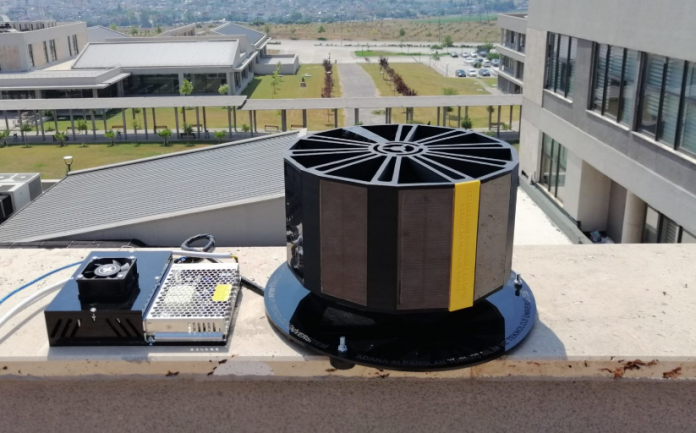Scientists from the Adana Science and Technology University in Turkey have designed a prototype of a rotary energy system (RES) that they claim may become a solution that is particularly suitable for domestic applications and high-rise buildings in regions with high wind energy and solar energy potential.
“The system was manufactured using 3D print technology and consists of a single structure,” research author, Abdurrahman Yavuzdeger, told pv magazine.”Its rotation movement produces air streams that are able to reduce the operating temperature of the solar panels and reduces dust accumulation considerably.”
The system has a decagonal shape and each of its sides hosts a polycrystalline photovoltaic panel with a size of 140×60×2.5 mm and a weight of just 33g. The modules are placed at a 30mm distance from one another and they have a power conversion efficiency of over 17%. Their rated voltage is 6V and the rated current is 100mA.
Air ducts measuring 95×150 mm are embedded between each of the system’s 10 sides to reduce the operating temperatures of the panels and, simultaneously, that of the whole system. A slip ring with an efficiency of around 96% has been used to solve the problem of entanglement of the cables in the solar modules.
A stepper motor Nema 23 for low-speed applications is used to rotate the system. It measures 56.4×56.4×76 mm and weighs in at 1kg. Its operating voltage is 8.6 V and its operating current is 1 A on each phase. A stepper motor driver TB6600 is used for rotation speed adjustment and the speed is controlled by a controller interface. The system’s rotating speed ranges from 0 to 100 revolutions per minute (rpm). A measurement station records ambient temperature and solar radiation data.
The system was operated 0, 10, 50, and 100 rpm/h and with solar radiation of between 110 and 1210 W/m2. “Although the highest irradiance value is at 10 rpm, the highest power value produced from the RES has been measured at 100 rpm,” the scientists said. “The cooling of the PV panels has been realized with the increase of the rotation speed.”
The highest output power of the system was found to be 1.8067 W at operating 100 rpm and 756 W/m2 solar radiation, while the lowest was 0.5698 W at operating 10 rpm and 234 W/m2 solar radiation.
“The total cost of the system is approximately 3500 TL ($288.6),” Yavuzdeger told pv magazine. “But these costs date back to 2018 when we began assembly the prototype.” Looking forward, the Turkish group said it wants to improve the system design and apply MPPT converter topologies to the device.
Described by its creators as reliable, silent, environmentally friendly, the system is presented in the paper Performance Assessment of a Novel Eco-Friendly Solar Panel Mounted Hybrid Rotating Energy System with Renewable Energy Applications, which was recently published in IETE Journal of Research.






